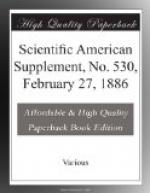[Footnote 4: The library of the New York Institution contains a copy of this very rare edition, bearing the title Abacus atque velustissima Latinorum per digitos manusque numerandi (quinetiam loquendi) consuetudo, etc., Ratisbonae, 1532.]
[Footnote 5: For an exhaustive account of the gesture speech in Anglo-Saxon monasteries and of the Cistercian monks, who were under rigid vows of silence, see F. Kluge: Zur Geschichte der Zeichensprache.—Angelsachsische indicia Monaslerialia, in International Zeitschrift fur Allgemeine Sprachwissenschaft, II. Band, I. Halfte. Leipzig, 1885.]
[Footnote 6: Reduccion de lasletras y arte para ensenar a hablar los mudos, 1620. The writer is under obligations to Sr. Santos M. Robledo, of the Ministry of Public Works and Education, for advance sheets of the reprint in beautiful facsimile of this rare work ordered by the Spanish Government in 1881.]
[Footnote 7: The Abbe de l’Epee did not master the Spanish alphabet, and, attaching but little importance to manual spelling, he was unsparing in his criticism of Messieurs the dactylologists, but by “the irony of fate” this alphabet occupies a face of the pedestal of one statue to his memory, and in another statue the good Abbe is represented either as receiving this alphabet from the skies or as devoutly using it.]
The first alphabet which appears to have been devised expressly for use in teaching the deaf is that of George Dalgarno, of Aberdeen (1626-1687), given in his remarkable philosophical treatise, Didascalocophus, or the Deaf and Dumb Man’s Tutor, Oxford, 1680. A facsimile of this alphabet is given in the Annals, vol. ix., page 19. Words are spelled by touching with your finger the positions indicated, either upon your hand or upon the hand of your interlocutor. An alphabet of the same character, however, was not unknown at an earlier date. For Bulwer, in 1648, says: “A pregnant example of the officious nature of the Touch in supplying the defect or temporall incapacity of the other senses we have in one Master Babington of Burntwood in the County of Essex, an ingenious gentleman, who through some sicknesse becoming deaf, doth notwithstanding feele words, and as if he had an eye in his finger, sees signes




